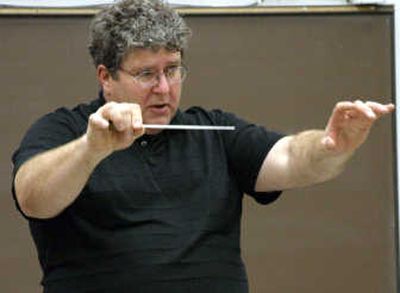Get Out! Concert helps ease seasonal transition

Each year, it begins with the slightest whiff of something in the air, a cool crispness which seems familiar but oddly foreign after a long spell of tepid summer evenings.
Windows that once stood permanently open at night are slammed shut in bouts of 4 a.m. chills. Pungent puffs of wood smoke drift from the rooftops in confabulation with the lumbering morning fog. Reluctant orange school buses return from their vacations, carting sharply dressed students off to attend their new classes in body only, for mentally they remain on the beach, at the mall, or on the couch in front of the Playstation or Xbox. Daylight hours rapidly shrink as the frost begins to do a heavy number on resplendently multicolored trees, causing suicidal leaves to pull a Peggy Lee and ask “Is that all there is?” before leaping to meet that final disappointment.
Fortunately, the Coeur d’Alene Symphony Orchestra is performing its annual Autumn Classic concert this evening at North Idaho College to help ease us through the seasonal transition and provide us with a chance to wrap ourselves in the majestic warmth and comfort of live classical music.
The Coeur d’Alene Symphony Orchestra has been one of the most cherished entities in the local arts and music scene since its formation nearly 30 years ago as the significantly smaller Coeur d’Alene Chamber Orchestra. Initially, membership was exclusive to students within the NIC music department. As interest grew, so did the need to expand the talent pool, and today the orchestra is open to anyone able to pass an audition.
According to orchestra manager Sandy Daniel, the Symphony League is continuously recruiting new members, cultivating interest by reaching out to young musicians in local area schools and providing scholarships for four talented students per year. Currently, the orchestra consists of around 70 members representing a diverse lot of ages, backgrounds, and musical areas of expertise.
This year marks David Demand’s sixth season in the role of conductor, and looking at his long and prestigious resume, we are lucky to have such a talent in our midst. Since graduating from Washington State University and studying at the Banff School of Fine Arts, Demand has had some amazing gigs. He was company pianist with the renowned Joffrey Ballet in New York, principal keyboardist with the Cedar Rapids Symphony, and has performed throughout the United States, Canada and Europe as a conductor, soloist and accompanist. He’s presently the director of music at Spokane’s Saint George’s school, the conductor of Coeur d’Alene’s popular Opera Plus! and somehow still manages to spend quality time with his wife and kids at home in Chattaroy.
Tonight’s Autumn Classic concert consists of three traditional classical pieces, each chosen to evoke the transitory beauty and color-shifting wonder of the season. The first composition is a short and distinctly upbeat tune by Russian composer Nikolai Rimsky-Korsakov titled “Procession of the Nobles.” Listening to the piece, one gets the feeling that Jack Frost and his icy henchmen are the Nobles in question, gleefully taking on and stamping out the warm afternoons of Indian summer.
Next is Franz Joseph Haydn’s four part “Symphony No. 101 in D Major,” more commonly known as the “Clock Symphony.” This 1874 piece is named for the clocklike ticking rhythm throughout the second movement, but it’s melancholic grandeur reminds these ears of the feeling one gets when daylight-saving time ends and the clock slips back an hour and darkness takes over most of our waking moments.
Lastly, Johannes Brahms’ “Double Concerto, Opus 102” playfully summons a storm on an ominously cloudy fall day, its brisk meter and pastoral violin phrases suggesting gusty winds blowing bright orange, red and yellow maple leaves into piles on the ground, each color made even more vibrant under the sheen of heavy raindrops. Adding to the composition’s autumnal mystique, it was Brahms’ last composition for the orchestra and was debuted in the heart of fall on Oct. 18, 1887, nearly 120 years ago to the day.
Bundle up in your warmest, comfiest sweater and scarf this evening. Brave the chill and come down to the toasty confines of the Schuler Auditorium in North Idaho College’s Boswell Hall and enjoy a performance by the splendid harvest of talented musicians who comprise one of the Inland Northwest’s finest large ensembles.